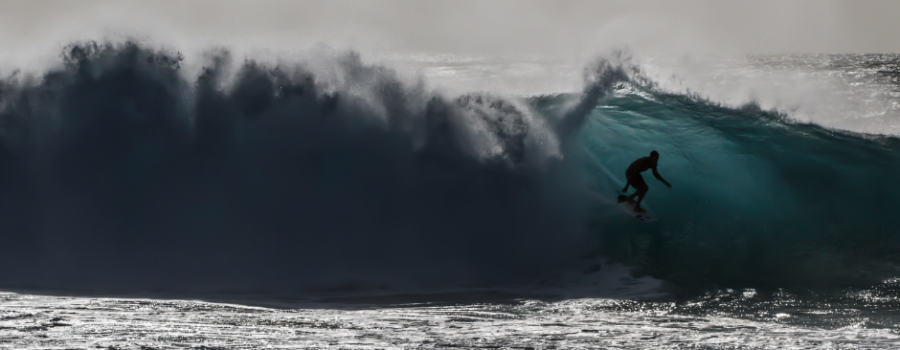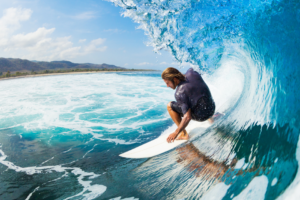When it comes to the ocean, she’s a beautiful but notoriously unpredictable force of nature. Surfing the waves might be fun and relaxing. Still, it also comes with its own dangers, so it’s always a great idea to know what steps to take to ensure your safety and the safety of those around you.
Here are just a few tips and tricks to maintain your safety in the water:
Pick the Right Beach
The presence of lifeguards, clear safety signs, and designated swim and surf zones indicate that the beach is well-maintained and regulated, increasing the safety of surfers.
Additionally, the type of waves, such as long and steady waves for beginners or more challenging breaks for advanced surfers, can influence the choice of beach and ensure you don’t get injured by tackling conditions you’re not used to.
By considering these factors, you can choose a beach that offers both a safe and enjoyable surfing experience.
Monitor the Surf Report
Surf Reports are an important tool for any surfer. They monitor conditions across the board and flag any potential dangers before you even hit the water.
The surf report typically includes information on the wave height, wind speed and direction, water temperature, and any potential hazards or advisories. With this information, surfers can make informed decisions about the suitability of the surf conditions.
There are many different websites and apps that can provide you with the surf report, so be sure to pick one that’s user-friendly for you!
Do Some Warm Ups before you hit the Waves
As laidback as the sport is, you’re still an athlete. All professional athletes know the trick to avoiding injury is to do a warm-up before you exercise. It doesn’t have to be something major, but a few stretches on the sand before you go sprinting through the breaks can save you from potentially hurting yourself on the water.
Sports injuries can be painful and put you out of commission for some time. Even the great Kelly Slater has had his fair share of off time due to injuries, so if you want to keep surfing, you better keep stretching!
Read the Waves
Reading waves is a critical skill for surfers, as it helps them determine where to catch a wave and avoid dangerous situations.
Here are a few steps that surfers can follow to learn how to read waves:
- Observe the sets: Watch the waves closely and take note of their frequency and size.
- Identify the Peak: Look for the highest point of the wave; this is usually where the wave will start to break.
- Study the Tide: The tide can affect how waves break, so it’s important to pay attention to the tide levels and how they change throughout the day.
- Watch Other Surfers: Observing other surfers can provide valuable insights into how waves break and the best spots for catching waves.
Use the Right Equipment
We don’t need to tell you the importance of having the right equipment. But, from your wet suit to your board, you need to ensure that your surf gear is ready to take to the waves.
Ensure your board isn’t cracked or broken, as it may snap on the water. Have a leash to stop you from taking too hard of a fall. And always ensure your wet suit can protect you from the harsh sun and cold water.
Know How to Handle an Emergency
Always keep a kit on hand, in the car, or on the beach. This could be a small first aid kit, or something a bit more targeted, that can help in case of injury! While it may not happen, it’s always a good idea to be prepared.
It’s also always advisable to have some first aid knowledge, especially CPR, which could be very useful one day. And if you want to go the extra mile, you can even wear a safety whistle, so when you find yourself in trouble, you can alert the lifeguards and those around you.
Respect Your Fellow Surfers
Respecting other surfers is vital; we all bustle for the best wave, but at the end of the day, only one will prevail to surf it. And truthfully, it won’t be the last wave of the day! Give your fellow surfers space, and make sure you don’t drop in on their waves; other than being a really uncool move, you can put both of you in harm’s way!
Respect Your Limits and Take it Slow.
Surfing is easygoing, but if you try and overexert yourself, you could cause damage to your health. So if you’re new to the sport, unfit, or haven’t been surfing in a while, take it easy and don’t overexert yourself.
Learn to take it slow, and when you feel fatigued, take a step back. The waves will still be there tomorrow!
Have a Surfing Buddy
Wasn’t it “Finding Nemo” where Crush the turtle asked, “Do you have an exit buddy?”. Well, the rule applies to surfing too. Plus, surfing with friends can be really fun! Be sure to have a surfing partner, someone who joins you out on the waves and can keep an eye on you and your surroundings to ensure you’re safe. You never know; one day, they might save your life.
Monitor the Weather
Keeping an eye on the weather is just as important when you’re in the water. Like the ocean, the weather can be unpredictable, and you wouldn’t want to be stuck out at sea when a storm rolls through. As you practice, you’ll notice subtle changes almost instinctually. For example, a shift in the wind, the color of the sky, and the movement of waves. After all, storms and poor weather conditions come with rip tides and rogue waves, which can put you in a dangerous situation.
Conclusion
But when it comes to safety and surfing, the best place to learn is from professionals. North Shore Beach Boyz is your one-stop destination to learn everything there is about surfing. You can rest easy knowing you’re in safe hands with trained professionals there to make sure every surf experience you have is safe, fun, and enjoyable to the fullest! Even the greats recommend taking a few surf lessons here and there; you might be surprised to learn something new!







Recent Comments